History: People
Their refusal to bear arms and to swear an oath meant that right from the inception of the religious movement, most professions were closed to Quakers as were politics and universities. However in the seventeenth century, Chelmsford and mid-Essex was primarily a farming area, as well as providing services for trade between London and East Anglia. This, together with the subsequent development of industry and commerce, and their reputation for fair and honest dealings gave many Mid-Essex Quakers an opportunity to exploit their talents as farmers, millers, shopkeepers, bankers, and tradesmen.
Following the opening of the Chelmer and Blackwater Navigation in 1797, cheaper transportation and raw materials made milling and malting the main industries until the 1850s, when increasing prosperity created a local market for agricultural machinery.
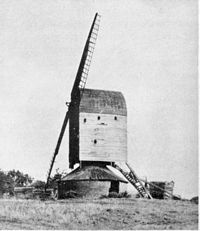
Windmill owned by Marriage family in Broomfield
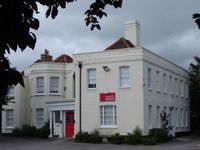
Coval Hall today, home of the Marriage family in the 19th century
The Marriage Family
An enduring thread through the history of Quakers in mid-Essex has been the Marriage family. The Marriages have been farmers and millers ever since they came to mid-Essex in the seventeenth century - possibly from France.
It is not clear at what point the family became Quakers, but records show that in 1701 Samuel and William Marriage were appointed as trustees for the new Chelmsford Meeting House in Baddow Road.
In 1824 William and Henry Marriage set up the family firm, W & H Marriage, millers, in Chelmsford that continues today. The expanding family prospered, and played a major part in the Quaker community of Chelmsford. Both William and Henry Marriage married members of the Christy family (see below) - William in 1839, and Henry in 1858.
The Quaker Register of Burials for the first half of the 19th century records many deaths due to symptoms similar to tuberculosis and dysentery, indicating that Chelmsford was far from a healthy environment. The sale of the Mildmay estate created in the 1840s a building boom that saw the construction of many grand houses on what is now New London Road, and on the land on both sides. This exacerbated the already unacceptable situation concerning the disposal of sewerage, and when cholera broke out, there was impetus to address 'the very filthy and unwholesome state of several of the drains and ditches' which discharged into the rivers. This eventually led to the formation in 1850 of a local Board of Health, on which both Thomas Marriage(1808-1888) and John Marriage (1811-1880) served, and which was instrumental in establishing more effective sanitation, as well as defining and imposing building standards in the town.
Charlotte Marriage, who was involved in the temperance movement, lived in Coval Hall in Chelmsford (now an estate agents).
Robert Greenwood
Robert Greenwood (1771-1834) of Springfield was the son of Robert Greenwood senior. The latter was a successful Quaker ironmonger, builders merchant, and property developer, and his son continued the business and became even wealthier. When he died in 1812, Robert senior left £100 for the rebuilding of the water conduit which provided fresh water from springs in Broomfield and routed them to the centre of the town. However, Robert Greenwood senior was not buried a Quaker! In 1795, and an Elder of the meeting, rumour associated his name with that of another man’s wife, and he failed satisfactorily to explain the circumstances, and so he was removed from membership and never restored. A banking crisis in 1826 resulted in local banks suspending trade, and the affluent Robert Greenwood younger became a partner in Sparrows bank in Chelmsford, and ended his days as a very respectable banker.
John Griffith
By the middle of the 18th century, Mid-Essex Quakers seemed to have been ground down by the constant harrying of the authorities. Whilst some refused to pay the church rate, and suffered confiscation of their goods, many paid up to avoid the humiliation of distraint; and the Monthly Meeting acknowledged that afherence to the 'Discipline' was wavering.
However the timely arrival in 1750 of a 35 year old Welshman, John Griffith, to Chelmsford was to reinvigorated Mid-Essex Quakers. John, a cabinet maker by trade, was the son of John and Amy Griffith of Radnorshire in South Wales. He had emigrated to America, where he became a member of Darby Quaker Meeting in Pennsylvania, but eventually returned to England a widower, with his daughter, Amy. He re-married and started a business in the High Street as a woollen and linen draper.
John had brought with him a certificate from the Quakers of the Darby Meeting in Pennsylvania testifying to their satisfaction with his 'conversation and ministry'. Griffith was a Quaker in the mould of those missionary Quakers to whom, as George Fox explained, '..God hath given a gift of the ministry, and who used to travel up and down in the ministry...'. preaching the Gospel. For twenty-six years Griffith was to exercise a profound influence upon the life of Mid-Essex Quakers. 'In Ministry sound, powerful and clear; in Discipline diligent and judicious', he represented Chelmsford Quakers at Monthly Meeting; Monthly Meeting at county Quarterly Meeting; and Quarterly Meeting at London Yearly Meeting. In 1752 Griffith was a member of the county committee set up by Quarterly Meeting charged with setting up womens business meetings in the county. In 1753, the county Quarterly Meeting , concerned 'at the weak and low estate of the meetings in this county', including weakness in Discipline, deputed a group of eight Quakers headed by John Griffith to visit Monthly Meetings in the county to counsel them....
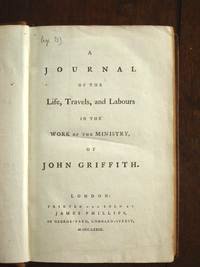
The printed Journal of John Griffith
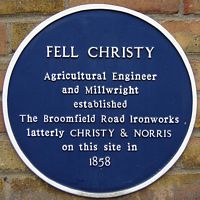
Plaque in Broomfield Road, Chelmsford
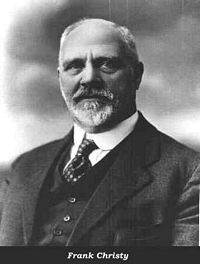
Frank Christy of Chelmsford
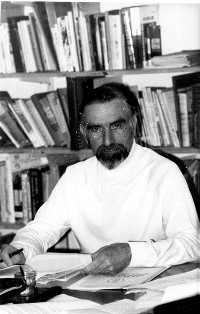
Study of Eric Baker
All of this was fitted into extensive travelling as an itinerant minister far beyond Essex. With a testimonial certificate from Monthly Meeting in his pocket, in 1751 - a year after arriving - he visited meetings in Worcester, Bristol, and Wales; then in 1757 he visited meetings in Kent and Sussex. This was followed in 1760 with a visit to Ireland, and later in the same year to Somerset, Dorset and Cornwall.
Then in 1765, with a certificate addressed 'To Friends in America', and attesting to the immense contribution that he had made to Mid-Essex Quakers, he set off for an extended visit, returning in 1767.
John Griffith died in June 1776. In a lasting tribute to him, Quakers arranged for his journal to be printed in 1779, with a testimony to his life written by Mid-Essex Quakers as a frontpiece. The Mid-Essex Quaker library has copies of this printed journal in its collection.
Richard Shoobridge
Records show that between 1771 and 1787 no fewer than thirty-seven Mid-Essex Quakers were regretfully 'disowned' after strenuous efforts to persuade them to mend their ways had failed. One of these was Richard Shoobridge, a cabinet maker by trade, who had come to Chelmsford in 1771 from Coggeshall Meeting. Richard had a passion for bell ringing. By 1770 the Chelmsford Parish Church of St Mary (later to become Chelmsford Cathedral) was in need of new bells, and a public subscription was opened to raise funds. When, in 1777, the new peal of eight bells was installed, one of them was inscribed with the names of three benefactors, one of which was 'R SHOOBRIDGE'.
Richard was disowned by Mid-Essex Quakers in 1778, not only for absenting himself from meetings, frequenting alehouses, and contributing to the hire of substitutes to serve in the militia, but also for taking part 'in the vain Diversion of Ringing Bells in the parish Worship House at Chelmsford', a practice which he refused to abandon.
The Christy Family
The Chelmsford foundry firm of Christy was originally founded by Fell Christy (1835-1918) in partnership with his father James Christy, a Chelmsford brickmaker, in 1858 at the corner of Kings Road and Broomfield Road. Originally millwrights, the company expanded and by 1897 had become Christy & Norris, manufacturing machinery for the food and agricultural industries. There are streets in Moulsham which still have road covers cast by Christy & Norris, and a road at the bottom of First Avenue is named after Fell Christy.
Another family company, Christy Bros, was established by Frank Christy (1866-1957) and Leonard Fell Christy, the sons of Fell Christy in 1883.Frank was a mere 18 years old, but had had a short apprenticeship with Crompton & Co. Colonel Crompton encouraged him to set up in business on his own as an electrical contractor. Over time Christy Bros became a major national contractor for electrical lighting, motors and switchgear.
Many of the Christy family were Quakers, and in the 19th century there were several marriages between the Christy and Marriage families.
Eric Baker - co-founder of Amnesty International
Eric was a member of Maldon Quaker Meeting. He registered as a conscientious objector during World War II, and during the war he worked on the ‘Famine Relief’ campaign, raising funds to send food to the war-torn European Continent. In 1946 he became joint secretary of the Quaker Centre in Delhi with his wife Joyce. Returning to England in 1948, he continued to work for Quaker Peace and Service (now Quaker Peace and Social Witness). He was elected the general secretary of the National Peace Council from 1954 to 1959, writing the thought-provoking article ‘Psychological warfare a challenge to democracy’.
Eric met Peter Benenson when he was sent on a Peace mission to Cyprus in 1954. The two men became friends. They discussed political, religious and ethical issues. Benenson later described him as a partner in the launch of his ‘Appeal for Amnesty 1961’. They met up and telephoned each other constantly throughout that year developing what is now Amnesty International. It was Eric who suggested the term ‘prisoner of conscience’. This was adopted and became central to Amnesty International, as did Eric’s view that they should support all those who were not advocating or condoning violence. At the end of their first year 10% of their prisoners were freed.
When Peter Benenson resigned as President in 1966, Eric became the first secretary general of AI. He was succeeded by Martin Ennals in1968.
